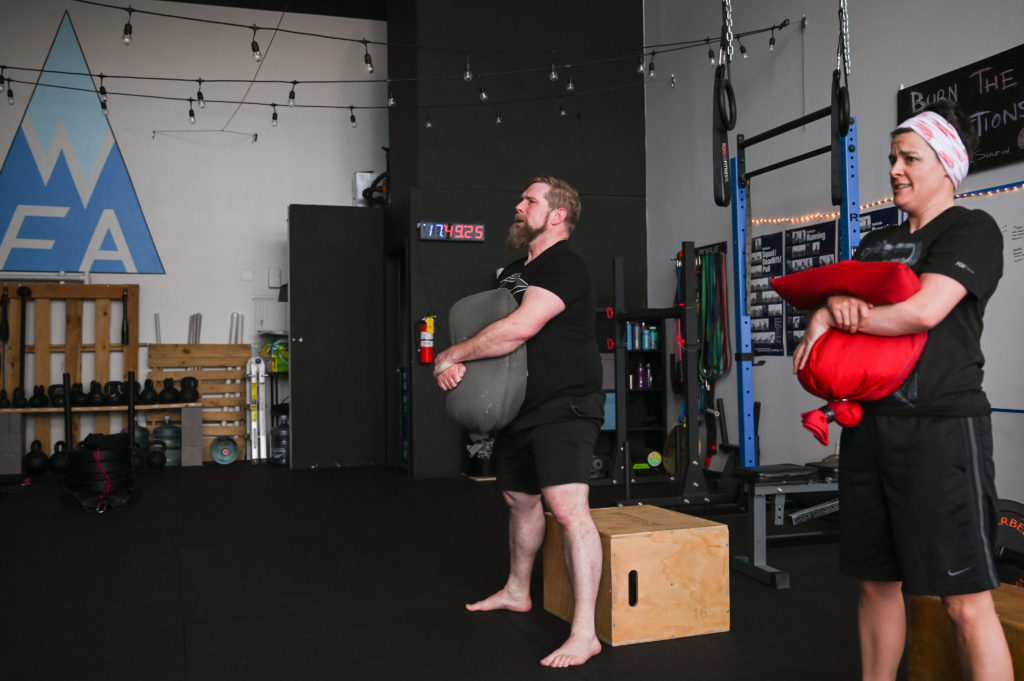I owe a lot to CrossFit; boxes in Rhode Island and Washington D.C. were my introduction to strength training, and intensity in conditioning. Coaching in a CrossFit box in Salt Lake City built my skills, and taught me to develop a coach’s eye for movement. Plus, it was a CrossFit box owner and physical therapist who challenged me to make my life’s work teaching people to move well. And I discovered StrongFit and Julien Pineau through a CrossFit-focused podcast.
But I see problems with CrossFit for most populations.
It’s helpful to distinguish between the two components of CrossFit:
Philosophy and Training Style
First, there’s the CrossFit training philosophy of intensity. Discomfort is essential for growth, and learning to be uncomfortable is the path to strength, size, fat loss, and improving sport performance.
We train with intensity too, but with a few notable changes. CrossFit programming often includes technical and high-risk exercises performed under intensity – overhead squats and deadlifts are notable examples. Can people overhead squat? Should people deadlift? Yes, but in controlled contexts. And CrossFit uses competition as a tool to push intensity; we ask people to push against their internal limits, and to support others in the gym.
In other words, we select exercises less likely to cause injury, and we build a community that’s cooperative rather than competitive.
Competition
The CrossFit Games has become, for many, what CrossFit is. If you’re not in the know, we’re talking about a global competition cycle that ends with a group of ~50 people competing together in the summer for the title of the “World’s Fittest.” But these aren’t everyday people; they’re gifted athletes with a long training history. They’re people who’ve committed themselves to this journey in terms of time, money, and often their relationships and health.
I like to watch bits of the CrossFit games. These athletes are badass. But these are professionals who have committed everything to the sport, and they’ve made the sport their primary goal.
The goal is to keep the goal the goal.
If your goal is to ski better, or climb better, or feel better and healthier and happier, there’s not a reason you need to train like a CrossFit Games athlete. You’ll probably be well served by moving well, and then layering on intensity to strengthen your mental resolve, and then practicing your sport with your newfound skills. Overhead squats simply aren’t applicable to most sports or lifestyle.
Here’s where CrossFit Evolved comes in.
There are a lot of coaches and gyms where the work looks like CrossFit, and the programming has a CrossFit-ish feel to it, and often, that’s because someone has spent time in the CrossFit community. And often, a coach started to question the CrossFit methodologies, and then took the concepts and reapplied them in a new and unique way.
For some, like Gym Jones and Mountain Tactical, the problem was that didn’t provide sport-specific improvements – soldiers and mountaineers were getting slower and weaker using CrossFit programming. For others like StrongFit and myself, CrossFit was overly focused on barbells and technical lifts, and I didn’t have enough stimulus to address my imbalances.
I consider Gym Jones, Mountain Tactical, and Wasatch Fitness Academy to all be in this category of “CrossFit Evolved” communities. Each gym will have its own feel and flavor; that feel is present in the messaging, the language, and the traditions and customs and rituals; the culture is set by the owners and the staff, and built up by the community. As you’re selecting a place to spend your time, your money, and your efforts towards fitness, try different things, explore different communities, and see what feels like a good fit for you.
And don’t be afraid to push your own evolution forward.

